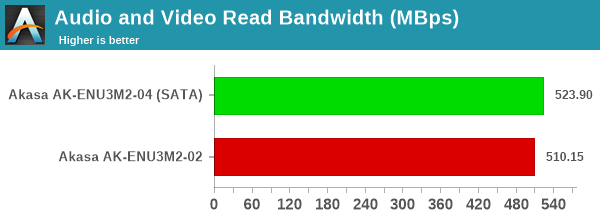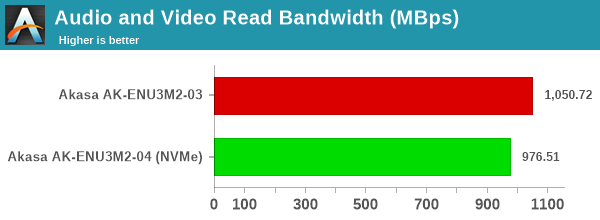Akasa M.2 SSD Enclosures Reviewed: Giving Spare Drives a New Lease of Life
by Ganesh T S on September 22, 2021 8:00 AM ESTAnandTech DAS Suite - Benchmarking for Performance Consistency
Our testing methodology for storage bridges takes into consideration the usual use-case for such devices. The most common usage scenario is transfer of large amounts of photos and videos to and from the unit. Other usage scenarios include the use of the unit as a download or install location for games and importing files directly from it into a multimedia editing program such as Adobe Photoshop. Some users may even opt to boot an OS off an external storage device.
The AnandTech DAS Suite tackles the first use-case. The evaluation involves processing five different workloads:
- AV: Multimedia content with audio and video files totalling 24.03 GB over 1263 files in 109 sub-folders
- Home: Photos and document files totalling 18.86 GB over 7627 files in 382 sub-folders
- BR: Blu-ray folder structure totalling 23.09 GB over 111 files in 10 sub-folders
- ISOs: OS installation files (ISOs) totalling 28.61 GB over 4 files in one folder
- Disk-to-Disk: Addition of 223.32 GB spread over 171 files in 29 sub-folders to the above four workloads (total of 317.91 GB over 9176 files in 535 sub-folders)
Except for the 'Disk-to-Disk' workload, each data set is first placed in a 29GB RAM drive, and a robocopy command is issue to transfer it to the external storage unit (formatted in exFAT for flash-based units, and NTFS for HDD-based units).
robocopy /NP /MIR /NFL /J /NDL /MT:32 $SRC_PATH $DEST_PATH
Upon completion of the transfer (write test), the contents from the unit are read back into the RAM drive (read test) after a 10 second idling interval. This process is repeated three times for each workload. Read and write speeds, as well as the time taken to complete each pass are recorded. Whenever possible, the temperature of the external storage device is recorded during the idling intervals. Bandwidth for each data set is computed as the average of all three passes.
The 'Disk-to-Disk' workload involves a similar process, but with one iteration only. The data is copied to the external unit from the CPU-attached NVMe drive, and then copied back to the internal drive. It does include more amount of continuous data transfer in a single direction, as data that doesn't fit in the RAM drive is also part of the workload set.

Both SATA bridges perform similarly for most workloads. In the cases where there is a significant difference, the pure SATA bridge (the AK-ENU3M2-02 with the VL716 bridge) comes out on top by a huge margin. Thermal throttling could be a reason for this, as we shall analyze further down.

Both NVMe bridges perform similarly for most workloads. In some cases, the pure NVMe bridge (the AK-ENU3M2-03 with the ASM3262 bridge) comes out on top. Thermal throttling is again responsible for this, as we shall see in the thermal solution evaluation.
In the absence of significant gulf in the numbers between the different units in the above workloads, the casual user will notice no difference between them in the course of normal usage. However, power users may want to dig deeper to understand the limits of each device. To address this concern, we also instrumented our evaluation scheme for determining performance consistency.
Performance Consistency
Aspects influencing the performance consistency include SLC caching and thermal throttling / firmware caps on access rates to avoid overheating. This is important for power users, as the last thing that they want to see when copying over 100s of GB of data is the transfer rate going down to USB 2.0 speeds.
In addition to tracking the instantaneous read and write speeds of the DAS when processing the AnandTech DAS Suite, the temperature of the drive was also recorded. In earlier reviews, we used to track the temperature all through. However, we have observed that SMART read-outs for the temperature in NVMe SSDs using USB 3.2 Gen 2 bridge chips end up negatively affecting the actual transfer rates. To avoid this problem, we have restricted ourselves to recording the temperature only during the idling intervals. The graphs below present the recorded data.
| AnandTech DAS Suite - Performance Consistency | |
| TOP: | BOTTOM: |
 |
|
 |
|
The first three sets of writes and reads correspond to the AV suite. A small gap (for the transfer of the video suite from the internal SSD to the RAM drive) is followed by three sets for the Home suite. Another small RAM-drive transfer gap is followed by three sets for the Blu-ray folder. This is followed up with the large-sized ISO files set. Finally, we have the single disk-to-disk transfer set. Despite the absence of any thermal solution, the WD Red SA500 behind the pure SATA bridge reaches a maximum of only 66C. On the other hand, the multi-protocol Realtek-based solution lands the SSD at 76C. It appears that the SSD starts to throttle around 75C, as can be seen from the frequent drops in the transfer rate in the second graph above.
| AnandTech DAS Suite - Performance Consistency | |
| TOP: | BOTTOM: |
 |
|
 |
|
A similar scenario plays out for the NVMe bridges. Temperatures top out at 66C for the ASMedia bridge solution, and 80C for the Realtek one. The throttling is evident in the disk-to-disk transfer set, where the Realtek solution drops down to around 800 MBps for the majority of the write transfer duration, while the ASMedia solution sustains 1000 MBps+ for a much longer duration.










15 Comments
View All Comments
ganeshts - Wednesday, September 22, 2021 - link
The Turing fanless case we reviewed last year is still doing great in deployment, and I don't think we have reviewed any Akasa gear after that. The storage bridges we reviewed in this article came in early last year, and the multi-protocol unit has been 'abused' greatly across multiple systems - has been working great for the last couple of months. The other two bridges were subject to only our evaluation process with a single host port, and that in itself is quite rigorous (multiple portable SSDs / storage bridges have experiences dropouts under heavy traffic, but no such issues with the Akasa bridges).Tomatotech - Thursday, September 23, 2021 - link
Thankfully I’ve successfully avoided buying any SATA m.2 drives. There must be people out there who were forced by circumstances into buying them, but I haven’t met any. Are there AnandTech readers out there who had to buy them?anad0commenter - Friday, September 24, 2021 - link
Does any of these work with the Plextor m6e AHCI PCIe m.2 SSD? It's one of the weirdest SSDs out there, which came out before NVMe became popular. And for the life of me, I can't find an enclosure that will work with it. SATA m.2 enclosures don't seem to be compatible.Tomatotech - Sunday, September 26, 2021 - link
I think you want an AHCI adaptor. It’s a little dongle about an inch wide that goes between the SSD and the m.2 socket. I’m not sure if we’re talking about the same thing here, but Apple used a weird type of SSD for several years 2013-2015ish. So there’s a bit of a market for adaptors to retrofit the Mac laptops so that they can use modern NVMe drives. I have 2 of these adaptors in my Mac laptops.The problem is the adaptors that are available are intended to let a modern nvme ssd fit into Apple’s weird socket (it was designed before the nvme standard was nailed down). What you’re after is an adaptor to let your weird drive fit into a modern socket. Good luck searching. I haven’t had much luck finding adaptors to let me re-use my surplus Apple OEM m.2(ish) drives as a portable ssd.
(Don’t want to sell my Apple OEM drives as some OS bootrom upgrades prefer the original drive in place.). TBH at this point in time I regard any non-NVMe ssd as a lost cause and effectively worthless, at least in the smaller sizes.
anad0commenter - Tuesday, September 28, 2021 - link
The adaptor was a good idea, but it turns out that it's only for macbooks, which use a 12+16 pin notch. So when I put the Plextor SSD on one side, the other side of the adaptor will not go into a standard m.2 slot which has a notch after 5 pins.There's a USB3.0 enclosure on ebay that claims it's AHCI NGFF compatible. But it costs $70!! Not sure if it's worth the risk to find out of it works with the Plextor....